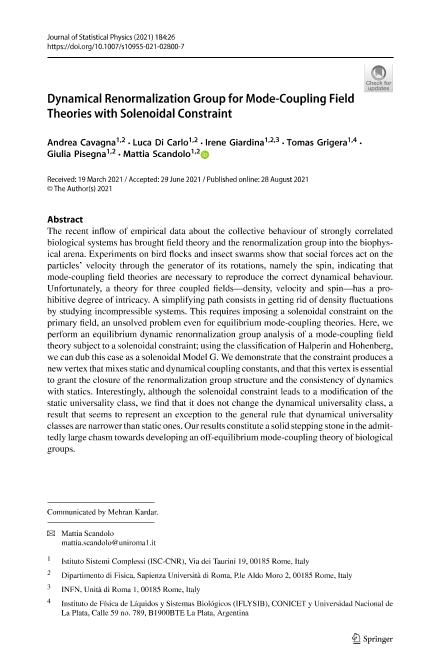Mostrar el registro sencillo del ítem
dc.contributor.author
Cavagna, Andrea

dc.contributor.author
Di Carlo, Luca

dc.contributor.author
Giardina, Irene
dc.contributor.author
Grigera, Tomas Sebastian

dc.contributor.author
Pisegna, Giulia

dc.contributor.author
Scandolo, Mattia
dc.date.available
2022-10-18T14:31:12Z
dc.date.issued
2021-09
dc.identifier.citation
Cavagna, Andrea; Di Carlo, Luca; Giardina, Irene; Grigera, Tomas Sebastian; Pisegna, Giulia; et al.; Dynamical Renormalization Group for Mode-Coupling Field Theories with Solenoidal Constraint; Springer; Journal of Statistical Physics; 184; 3; 9-2021; 1-36
dc.identifier.issn
0022-4715
dc.identifier.uri
http://hdl.handle.net/11336/173803
dc.description.abstract
The recent inflow of empirical data about the collective behaviour of strongly correlated biological systems has brought field theory and the renormalization group into the biophysical arena. Experiments on bird flocks and insect swarms show that social forces act on the particles’ velocity through the generator of its rotations, namely the spin, indicating that mode-coupling field theories are necessary to reproduce the correct dynamical behaviour. Unfortunately, a theory for three coupled fields—density, velocity and spin—has a prohibitive degree of intricacy. A simplifying path consists in getting rid of density fluctuations by studying incompressible systems. This requires imposing a solenoidal constraint on the primary field, an unsolved problem even for equilibrium mode-coupling theories. Here, we perform an equilibrium dynamic renormalization group analysis of a mode-coupling field theory subject to a solenoidal constraint; using the classification of Halperin and Hohenberg, we can dub this case as a solenoidal Model G. We demonstrate that the constraint produces a new vertex that mixes static and dynamical coupling constants, and that this vertex is essential to grant the closure of the renormalization group structure and the consistency of dynamics with statics. Interestingly, although the solenoidal constraint leads to a modification of the static universality class, we find that it does not change the dynamical universality class, a result that seems to represent an exception to the general rule that dynamical universality classes are narrower than static ones. Our results constitute a solid stepping stone in the admittedly large chasm towards developing an off-equilibrium mode-coupling theory of biological groups.
dc.format
application/pdf
dc.language.iso
eng
dc.publisher
Springer

dc.rights
info:eu-repo/semantics/openAccess
dc.rights.uri
https://creativecommons.org/licenses/by/2.5/ar/
dc.subject
COLLECTIVE BEHAVIOUR
dc.subject
DYNAMIC RENORMALIZATION GROUP
dc.subject
MODE-COUPLING
dc.subject
SOLENOIDAL FIELD
dc.subject.classification
Física de los Materiales Condensados

dc.subject.classification
Ciencias Físicas

dc.subject.classification
CIENCIAS NATURALES Y EXACTAS

dc.title
Dynamical Renormalization Group for Mode-Coupling Field Theories with Solenoidal Constraint
dc.type
info:eu-repo/semantics/article
dc.type
info:ar-repo/semantics/artículo
dc.type
info:eu-repo/semantics/publishedVersion
dc.date.updated
2022-09-29T13:49:50Z
dc.journal.volume
184
dc.journal.number
3
dc.journal.pagination
1-36
dc.journal.pais
Alemania

dc.journal.ciudad
Berlin
dc.description.fil
Fil: Cavagna, Andrea. Università degli Studi di Roma "La Sapienza"; Italia. Consiglio Nazionale delle Ricerche; Italia
dc.description.fil
Fil: Di Carlo, Luca. Università degli Studi di Roma "La Sapienza"; Italia. Consiglio Nazionale delle Ricerche; Italia
dc.description.fil
Fil: Giardina, Irene. Consiglio Nazionale delle Ricerche; Italia. Università degli Studi di Roma "La Sapienza"; Italia
dc.description.fil
Fil: Grigera, Tomas Sebastian. Consejo Nacional de Investigaciones Científicas y Técnicas. Centro Científico Tecnológico Conicet - La Plata. Instituto de Física de Líquidos y Sistemas Biológicos. Universidad Nacional de La Plata. Facultad de Ciencias Exactas. Instituto de Física de Líquidos y Sistemas Biológicos; Argentina. Consiglio Nazionale delle Ricerche; Italia
dc.description.fil
Fil: Pisegna, Giulia. Università degli Studi di Roma "La Sapienza"; Italia. Consiglio Nazionale delle Ricerche; Italia
dc.description.fil
Fil: Scandolo, Mattia. Università degli Studi di Roma "La Sapienza"; Italia. Consiglio Nazionale delle Ricerche; Italia
dc.journal.title
Journal of Statistical Physics

dc.relation.alternativeid
info:eu-repo/semantics/altIdentifier/doi/http://dx.doi.org/10.1007/s10955-021-02800-7
dc.relation.alternativeid
info:eu-repo/semantics/altIdentifier/url/https://link.springer.com/article/10.1007/s10955-021-02800-7
Archivos asociados
